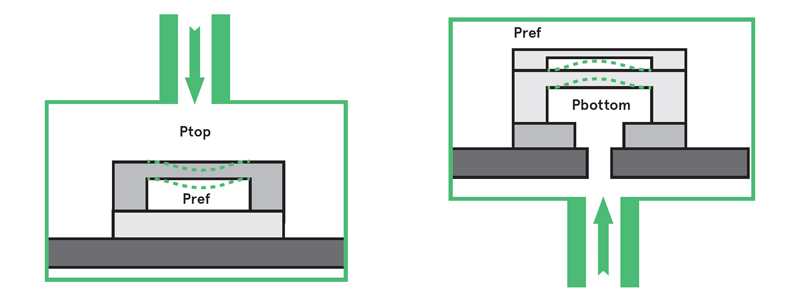MEMS sensors
It’s easy to imagine a piezoresistive or capacitive pressure sensor as a large device like a through-hole electronic component or a module ready to screw into the side of a tank – but that’s not always the case.
A piezo or capacitive pressure-sensing mechanism can also be fabricated on silicon as a MEMS (Micro Electro Mechanical System) device and packaged as a compact surface-mount device typically measuring only about 2-3mm per side.
MEMS devices, which include not only pressure sensors but also motion or position sensors, and silicon microphones, are extremely small, stable, and cost-effective, bringing advanced functionality to space- and cost-constrained equipment like mobiles and IoT endpoints.
MEMS devices are fabricated in silicon using doping and etching processes. These processes are performed at chip scale, resulting in a tiny device that can be co-packaged with signal-conditioning electronics. The electronic circuitry may comprise simple amplification to produce an analogue output, and may also include analogue-to-digital conversion to generate a digital output.
An analogue output may be advantageous if the sensor signal is to be handled entirely in the analogue domain, or if the designer wants to use an ADC of particularly high resolution or accuracy, or if the system-host microcontroller contains a suitable integrated ADC on-chip. A digital sensor can be designed-in with no need for external conversion components, thereby saving overall component count.
Perhaps the easiest type of sensor to visualise is a barometric pressure sensor. These can be used for measuring ordinary atmospheric pressure, and are used in a range of applications including context sensing or indoor navigation in smartphones. Typically, this is a tiny MEMS sensor.
Detecting changes in atmospheric pressure enables the device to theoretically be able to calculate its height above sea level – for example on a road (to assist satellite navigation and aid dead reckoning in the event of loss of satellite signal), or to detect what level of building the user is situated, such as in a multi-storey car park, office block, apartment block, or shopping mall.
Design considerations
Understanding the types of sensors in common use, their operating principles, and modes of use (absolute, gauge, or differential) can help engineers make initial selection decisions when identifying the most suitable sensor to choose for a given application.
The materials used and type of construction can have an important influence over aspects such as the measurement range, limiting factors like the maximum survivable pressure to which a sensor can be exposed, its stabilising time after soldering, and long-term stability in the intended application.
An understanding of the electrical output properties, and the circuitry needed to interact properly with the host electronic system – typically a microcontroller- or microprocessor-based control system — can help assess how the choice of pressure sensor will influence the likely electronic integration challenges.
This introduction only scratches the surface of pressure sensor technology. Chapter 1.2 will explore the different types of sensing elements that are used in pressure sensors, how they work, and their advantages and disadvantages. If you're looking for more detail on anything discussed here, you can check out the later chapters of this guide below. Alternatively, if you're pressed for time, the full guide is available as a downloadable PDF here.
For more information on our other sensor technologies, visit our sensors page.



